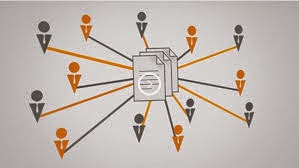Accounting Notes
v
Financial Statement:- Financial Statement is that
statement whic
h is represent the total financial picture of a business. In this
include the balance sheet and the profit and loss account.
v
Balance Sheet:- It is one of the primary financial statement.
The Balance sheet reflects a ‘point in time’;
v
Accounting Policies:- The accounting policies refer to the
specific accounting principles and the methods of applying those principles adopted
by the enterprise in the preparation and presentation of financial statements.
v
Notes to Accounts:-Notes to Accounts are the explanation
of the management about the items in financial statement(Profit and loss
account and Balance sheet).
v
Journal:-Journal is a book of original entry
wherein transactions are recorded in a chronological order.
v
Double entry system:-According to this system every
business transaction affects at least two accounts in opposite directions.
v
Ledger:-Ledger may be defined as a book
containing a set of accounts.
v
Posting:-Posting is a process of entering in
the ledger the information contained in the books.
v
Balancing of Accounts: - Equalization of the debit and
credit side of accounts by putting the difference on the side having lesser
total is called Balancing of Accounts.
v
Trail Balance:- Trail Balance may be understood as a
statement containing the total of debit and credit side of each account or the
balance of each and every account.
v
Cost of Goods Sold:- Cost of goods sold is the direct
cost of goods sold during the accounting period.
Cost of goods sold=Opening stock+Purchases+All
Direct expenses-Closing stock.
v
Direct Expenses:- Direct expenses are those expenses
which are incurred for putting the goods in saleable conditions. http://chandankumarsingh777.blogspot.in
v
Profit and Loss Account:- This statement is prepared to
calculate the net profit or net loss of the business.
v
Net Profit:- The excess of income side(credit) of
profit and loss account over expenditure(debit) side shows net profit of
business. Net Profit=Gross Profit-Expenses.
v
Outstanding Expenses:- At the end of the accounting year some of the expenses may remain
outstanding,ie. Not paid is called outstanding expenses.
v
Accrued Income:- An income earned but not due is
called accrued income.
v
Bad Debts:- If amount to be receivable form a
customer is not received it become a bad debt and the same is treated as
business expenses or loss.
v
Capital Expenditure:-Capital expenditure is that
expenditure which is incurred for acquiring any fixed assets for the business
or for raising capital or for enhancing working capacity of the concern.
v
Revenue Expenditure:- Revenue expenditure is that
expenditure which is incurred for day to day working, to maintain and operate
the assets in good working conditions. its benefit not more than one accounting
period.
v
Asset: - Assets are the possession and
properties of the business. These assets may be fixed or current assets. These
show how the funds of the business have been applied.
v
Bank Reconciliation Statement:- BRS is a statement prepared at a
periodical intervals reconciling the balance as per bank column of cash book
with the bank pass book of the customer.
v
Inventory:- The inventory as an asset that are
intended for sale, are in process of being produced for sale or are to be used
in producing goods. These are three
types:-Finished goods, Work in progress, and Raw material.

No comments:
Post a Comment